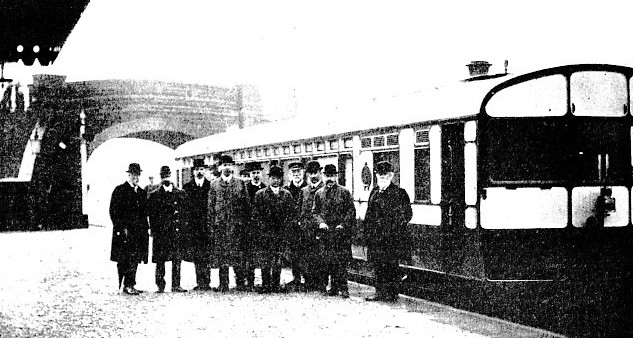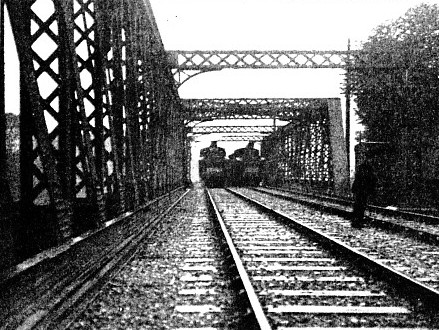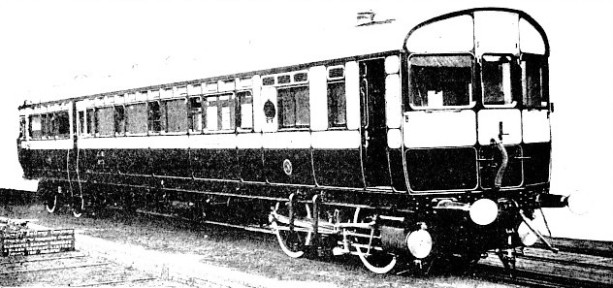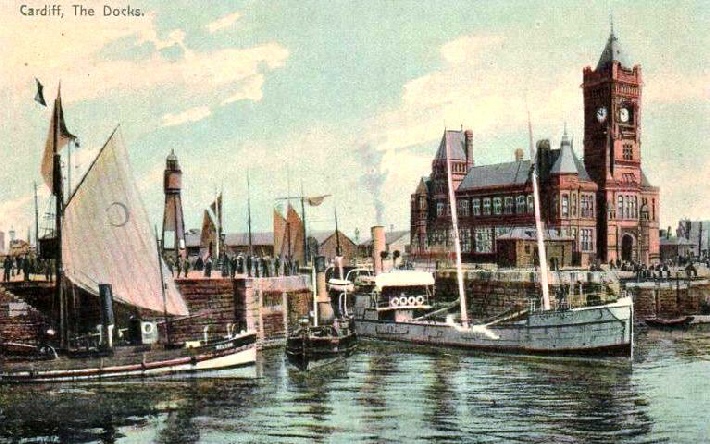
© Railway Wonders of the World 2012-


The Cardiff Railway

RHYD-
THE opening of the Cardiff Railway for passenger traffic took place in March 1911, from Heath Junction, north of the Cardiff Station of the Rhymney Railway, to Rhyd-
The Cardiff Railway was only incorporated on August 6th, 1897, although portions of the Cardiff Docks, which form an important part of the property of the Cardiff Railway, had been in use for many years — the Bute Dock as long ago as 1837. In connection with this dock there was about 130 miles of railways, which, as the dock estate has grown, and the docks have been increased, has also extended and junctions were made with the Great Western Railway, Taff Vale Railway, and the Rhymney Railway. Locomotives were provided by the Marquis of Bute (the owner of the docks prior to the incorporation of the Cardiff Railway) for the purpose of dealing with the coal and other traffic brought to the docks by the railway companies mentioned.
The Queen Alexandra Dock, which is the largest dock at Cardiff, is described later in this chapter. The connection between the new railway and the dock lines of the Cardiff Railway is by means of running powers over the Rhymney Railway. At present it is not proposed to run the Cardiff Railway’s passenger service to and from the docks. The trains will terminate at, and start from, the Rhymney Railway’s Cardiff Station.
Leaving the Rhymney Railway at Heath Junction — 1 mile 72 ch. from the Rhymney Railway’s station, the new railway terminates by a junction with the Taff Vale Railway at Treforest. Many physical difficulties were met with in the construction of the line, but the skill of the engineers successfully surmounted them. The new railway passes along the Taff Valley (already occupied by the River Taff, the Merthyr main road, the Glamorganshire Canal, and the Taff Vale Railway) so that much ingenuity was required to find room for the Cardiff Railway. Most of the 42 bridges on the new railway are built on the skew. The Merthyr road is crossed five times, the canal thrice and the River Taff only once, but its course had to be diverted for 1,200 feet near Nantgarw, otherwise the crossings would have been more frequent. The stream was turned into a new channel 80 ft. wide, out of which over 50,000 cubic yards of material were excavated. At places the river and canal are close together, and the railway had to be driven between. On the northern portion the canal is on the higher level, and considerable skill was displayed in keeping up the banks, as they were imperilled by the railway being cut so near and at a lower level.
Near Castell Coch there is perhaps the tightest fit in the valley, here the railway is close to the canal, and it then passes under the Merthyr road, beneath which at this point was laid the main water supply of Cardiff, a gas main, two smaller water mains, and a high-
South of Treforest the River Taff is crossed by the Treforest Viaduct. This viaduct is 457 feet long between the parapets. The rails are 55 feet above the bed of the river. The line is double throughout, with four lines through some of the stations. The gradients are easy, and generally with the load.

TESTING THE MERTHYR ROAD SKEW BRIDGE on the Cardiff Railway with ten locomotives.
Two contracts were let for the construction of the line, the first, to Messrs. Monk and Newell, of Liverpool, for the length from the Heath to Tongwynlais, which included exchange sidings at the Heath and a shunting neck, 900 feet long, running parallel with the Rhymney Railway near the filter beds of the Cardiff Corporation. In this contract there were four cuttings, from which 622,340 cubic yards of material were removed. Contract No. 2, for the remaining section, which was somewhat delayed, principally owing to the death of the late Marquis of Bute, which was let to Messrs. T. Oliver and Sons, of Westminster, proved to be a much greater undertaking, some 917,000 cubic yards of filling being required, whilst eleven cuttings had to be negotiated. Taking into consideration the many difficulties to be contended with,, it is not surprising that an eminent railway engineer described it as one of the most interesting bits of engineering he had ever seen.
The line was finished a year or two before opening, but owing to various difficulties, which need not now be gone into, delay occurred in its being opened for traffic, but in the summer of 1910 the construction of the passenger and goods stations was put in hand and orders given for the construction of rail motors for working the passenger services.
The engineering strike at the commencement of the winter of 1910 delayed the delivery of the locomotives, or the line would have been opened some four months earlier than it was.
A preliminary trip over the line was made on February 27th 1911, when the Marquis of Bute started the rail motor car on the new railway, amidst congratulations and a fusilade of fog signals. The
Marquis also drove the locomotive of the mineral train which passed over the railway when the permanent way was completed in May, 1909. The public opening of the railway took place on March 1st 1911, the first train leaving the Cardiff Station of the Rhymney Railway at 9.55 a.m. Amongst those travelling by the train were:— Mr. C. S. Denniss (the General Manager), Captain T. N. Rosser (Dockmaster), Mr. W. J. Holloway (Traffic Superintendent), Mr. G. W. Howard (General Manager of the Gloucester Carriage and Wagon Works, the builders of the passenger motor cars), Mr. E. A. Prosser (General Manager Rhymney Railway), Mr. A. E. Caswell (of the General Manager’s office) and Mr. Richard Thomas (Berthing Master), the oldest employee in the service of the Cardiff Railway.
The train carried twelve first class and thirty-
The first passenger to purchase a ticket was a lady, who pleaded hard to be allowed to retain it as an interesting memento; but the Cardiff Railway Company exercised its right to collect the ticket, which has since found its way to Cardiff Castle, and a place there amongst the curiosities in the possession of the Marquis of Bute.
On the return journey, in a special saloon, the toast of “success to the Cardiff Railway Company” was proposed by Mr. G. W. Howard, and suitably responded to by Mr. C. S. Denniss, who, in the course of his speech, thanked them for their good wishes in this new project, which had presented so many difficulties in its inception and development. The sun was shining upon them that day, and he hoped it was a good augury, not only for the Company, but also for the trade and commerce of Cardiff and the colliery district of the neighbourhood. He was glad to see among them Mr. Thomas Taylor, who was sinking the first pit on the side of the Cardiff Extension Railway. Both he and Mr. Prosser would welcome big loads of coal from the colliery, and they hoped the opening of the new line would inaugurate a very great development of the district.
The signalling on the new line was been carried out by Messrs. McKenzie and Holland. The passenger stock consists of two (1st and 3rd) composite motor coaches, and two 3rd class trailer coaches. These were supplied by the Gloucester Railway Carriage and Wagon Co. Ltd. to the Cardiff Railway for working the passenger service over the new line.
The motor coaches are constructed with a self-
All the cars are 65 ft. 0 in. long over mouldings, 9 ft. 0 in. wide and 8 ft. 0 in. high from floor to roof inside.
The motor coaches are divided into first and third class compartments, separated by an entrance vestibule, and are arranged to seat 16 first class and 48 third class passengers. The trailer cars are third class only, but consist of two compartments, separated in the same way as those in the motor coaches. The seating accommodation in this vehicle is for 80 passengers.
The Car bodies are framed in teak and oak with panels of Honduras mahogany and outside light mouldings of polished mahogany. The roof, floor and interior casings are of yellow pine. The interior of roof is lined with three-
Passengers enter and leave the cars from level crossings by means of swinging steps controlled from the vestibule by a lever which folds the steps under an ordinary step board when not in use. Long brass commode handles are attached to these steps, and, being jointed, fold up with them.
The cars are lighted by gas, are provided with steam heaters and a perfect system of ventilation, the air in the vehicles being noticeably fresh and sweet, even when the windows are closed.
There is electric communication between the motor end of the rear-
The exterior of the carriages is painted and varnished, the lower panels being finished in lake and the upper in light cream colour, the whole representing a very handsome appearance.

FIRST AND THIRD CLASS COMPOSITE rail motor of the Cardiff Railway.
All the work was been carried out under the supervision of Mr. Henry Ree, M. Inst. C.E., Engineer to the Cardiff Railway.
The Cardiff Railway also possesses 32 locomotives and 973 goods vehicles.
The total length of the Dock line in single track (including the sidings) is 126 miles.
There are four passenger stations and five halts on the new line. From Cardiff these are as follows:—The Heath (halt), Rhubina (halt) Whitchurch,Coryton(halt), Tongwynlais,Glan-
Dealing with the Docks belonging to the Cardiff Railway, they consist of five docks proper, the Bute West Dock, with a water area of 19½ acres; Bute East Dock, 46¼ acres; Roath Dock, 33 acres; Roath Basin, 12 acres; and the Queen Alexandria Dock, which is the largest of the five, having 52 acres.
The Docks, since their opening in 1840, have gone ahead amazingly, the imports for 1910 amounting to 1,854,430 tons, the exports being 10,327,765 tons. The Bute Docks (as the Docks of the Cardiff Railway are usually called) are not dependent alone on the exportation of coal for revenue, they are the only docks in South Wales licensed by the Board of Trade for the importation of one of the staple food products of the British Isles, viz. cattle. The Roath Dock has been selected to deal with this traffic, and cattle lairs have been provided alongside the lock leading to this dock.
Adjacent to these lairs are the abattoirs, from whence the carcases of the slaughtered cattle pass to the chill rooms, or maybe to the delivery passage. Cold-

THE OFFICES OF THE CARDIFF RAILWAY at the pier head, Bute Docks, Cardiff.
Grain of various sorts is also extensively handled, one warehouse being sufficient to hold 50,000 quarters at one time. Into this dock, too, come the timber vessels from all parts, conveying principally pitwood and mining timber, for use in the mines of the South Wales coalfield. Teak and other timbers, including railway sleepers and ships’ timber, also arrive at this dock in large quantities. Most of this is temporarily stored in the Cardiff Railway’s East Moors Sidings.
The Queen Alexandra Dock, with a water area of 52 acres, was opened on July 13th, 1907, by His late Majesty King Edward VII. This dock, which was rendered necessary by the rapidly growing trade of the Cardiff Docks, is the largest of the five basins comprising the Bute Docks, and provides, in fact, nearly one-
Colonel Charles Sherwood Denniss, the General Manager of the Cardiff Railway, comes from a railway family, his father having been the Superintendent of the Hull district of the North-
General Manager of that system. He ably fulfilled this office for a period of 14 years, and at the commencement of 1910 he was appointed General Manager of the Cardiff Railway.
You can read more on “The Festiniog Ralway”, “The Fishguard Boat Express” and “The Great Western Railway” on this website.